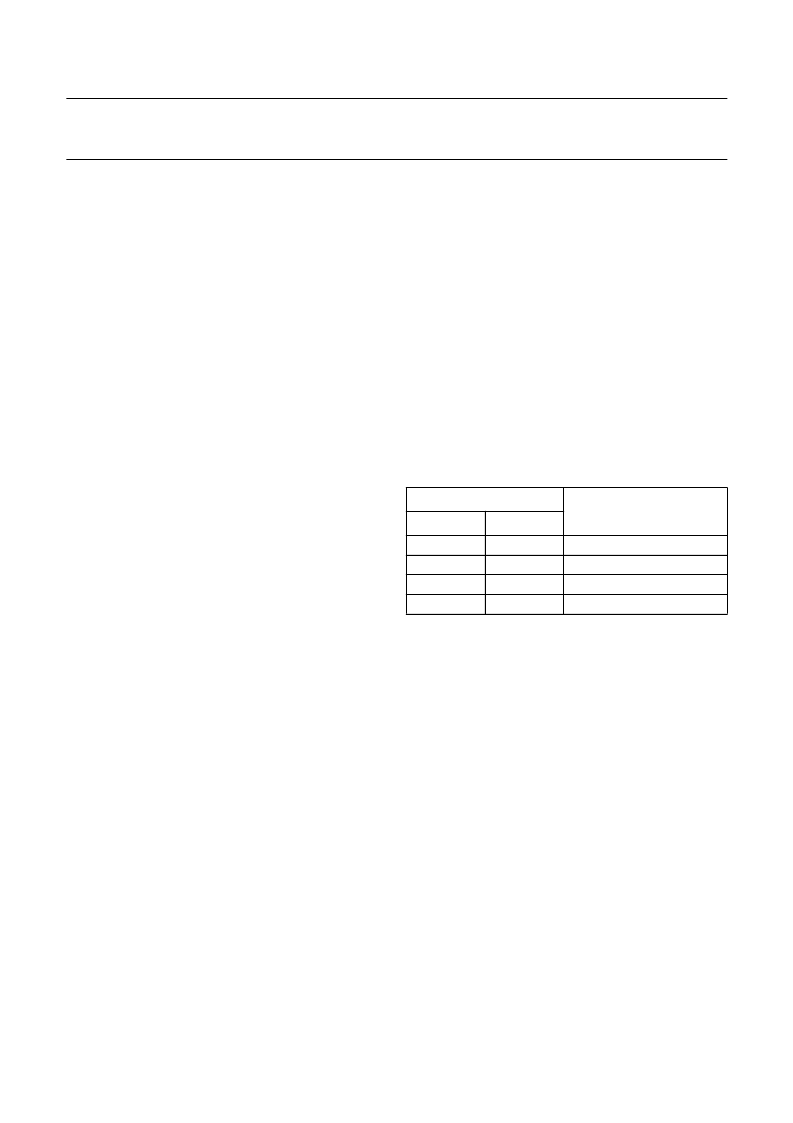- 您現(xiàn)在的位置:買賣IC網(wǎng) > PDF目錄382721 > UDA1351 (NXP Semiconductors N.V.) 96 kHz IEC 958 audio DAC PDF資料下載
參數(shù)資料
| 型號: | UDA1351 |
| 廠商: | NXP Semiconductors N.V. |
| 英文描述: | 96 kHz IEC 958 audio DAC |
| 中文描述: | 96千赫音頻DAC東區(qū)走廊958 |
| 文件頁數(shù): | 16/36頁 |
| 文件大小: | 157K |
| 代理商: | UDA1351 |
第1頁第2頁第3頁第4頁第5頁第6頁第7頁第8頁第9頁第10頁第11頁第12頁第13頁第14頁第15頁當前第16頁第17頁第18頁第19頁第20頁第21頁第22頁第23頁第24頁第25頁第26頁第27頁第28頁第29頁第30頁第31頁第32頁第33頁第34頁第35頁第36頁

2000 Feb 18
16
Philips Semiconductors
Preliminary specification
96 kHz IEC 958 audio DAC
UDA1351H
8.7
L3 interface
8.7.1
G
ENERAL
TheUDA1351HhasanL3 microcontrollerinterfaceandall
the digital sound processing features and various system
settings can be controlled by a microcontroller.
The controllable settings are:
Restoring L3 defaults
Power-on
Selection of input channel, clock source, DAC input and
external input format
Selection of filter mode and settings of treble and bass
boost
Volume settings
Selection of soft mute via cosine roll-off (only effective in
L3 control mode) and bypass of auto mute
Selection of de-emphasis.
The readable settings are:
Mute status of interpolator
PLL locked
SPDIF input signal locked
Audio Sample Frequency (ASF)
Valid PCM data detected
Pre-emphasis of the IEC 958 input signal
ACcuracy of the Clock (ACC).
The exchange of data and control information between the
microcontroller and the UDA1351H is LSB first and is
accomplished through a serial hardware L3 interface
comprising the following pins:
L3DATA: data line
L3MODE: mode line
L3CLK: clock line.
The exchange of bytes via the L3 interface is LSB first.
The L3 format has 2 modes of operation:
Address mode
Data transfer mode.
The address mode is used to select a device for a
subsequent data transfer. The address mode is
characterized by L3MODE being LOW and a burst of
8 pulses on L3CLOCK, accompanied by 8 bits (see Fig.6).
The data transfer mode is characterized by L3MODE
being HIGH and is used to transfer one or more bytes
representing a register address, instruction or data.
Basically 2 types of data transfers can be defined:
Write action: data transfer to the device
Read action: data transfer from the device.
Remark: when the device is powered up, at least one
L3CLOCK pulse must be given to the L3 interface to
wake-uptheinterfacebeforestartingsendingtothedevice
(see Fig.6). This is only needed once after the device is
powered up.
8.7.2
D
EVICE ADDRESSING
The device address consists of 1 byte with:
Bits 0 and 1 (called DOM bits) representing the type of
data transfer (see Table 5)
Bits 2 to 7 (address bits) representing a 6-bit device
address.
Table 5
Selection of data transfer
8.7.3
R
EGISTER ADDRESSING
After sending the device address, including Data
Operating Mode (DOM) bits indicating whether the
information is to be read or written, 1 data byte is sent
using bit 0 to indicate whether the information will be read
or written and bits 1 to 7 for the destination register
address.
Basically there are 3 methods for register addressing:
1.
Addressing for write data: bit 0 is logic 0 indicating a
write action to the destination register, followed by
bits 1 to 7 indicating the register address (see Fig.6)
2.
Addressing for prepare read: bit 0 is logic 1 indicating
that data will be read from the register (see Fig.7)
3.
Addressingfordatareadaction:inthiscasethedevice
returns a register address prior to sending data from
that register. When bit 0is logic 0, theregister address
is valid; in case bit 0 is logic 1 the register address is
invalid.
DOM
TRANSFER
BIT 0
BIT 1
0
1
0
1
0
0
1
1
not used
not used
write data or prepare read
read data
相關PDF資料 |
PDF描述 |
|---|---|
| UDA1351H | 96 kHz IEC 958 audio DAC |
| UDA1351TS | 96 kHz IEC 958 audio DAC |
| UDA1352HL | 48 kHz IEC 60958 audio DAC |
| UDA1360 | Low-voltage low-power stereo audio ADC |
| UDA1360TS | Low-voltage low-power stereo audio ADC |
相關代理商/技術參數(shù) |
參數(shù)描述 |
|---|---|
| UDA1351H | 制造商:PHILIPS 制造商全稱:NXP Semiconductors 功能描述:96 kHz IEC 958 audio DAC |
| UDA1351H/N1,551 | 功能描述:數(shù)模轉換器- DAC 96 KHZ SPDIF DAC RoHS:否 制造商:Texas Instruments 轉換器數(shù)量:1 DAC 輸出端數(shù)量:1 轉換速率:2 MSPs 分辨率:16 bit 接口類型:QSPI, SPI, Serial (3-Wire, Microwire) 穩(wěn)定時間:1 us 最大工作溫度:+ 85 C 安裝風格:SMD/SMT 封裝 / 箱體:SOIC-14 封裝:Tube |
| UDA1351H/N1,557 | 功能描述:數(shù)模轉換器- DAC 96 KHZ SPDIF DAC RoHS:否 制造商:Texas Instruments 轉換器數(shù)量:1 DAC 輸出端數(shù)量:1 轉換速率:2 MSPs 分辨率:16 bit 接口類型:QSPI, SPI, Serial (3-Wire, Microwire) 穩(wěn)定時間:1 us 最大工作溫度:+ 85 C 安裝風格:SMD/SMT 封裝 / 箱體:SOIC-14 封裝:Tube |
| UDA1351TS | 制造商:PHILIPS 制造商全稱:NXP Semiconductors 功能描述:96 kHz IEC 958 audio DAC |
| UDA1351TS/N1,512 | 功能描述:數(shù)模轉換器- DAC 96KHZ SPDIF DAC RoHS:否 制造商:Texas Instruments 轉換器數(shù)量:1 DAC 輸出端數(shù)量:1 轉換速率:2 MSPs 分辨率:16 bit 接口類型:QSPI, SPI, Serial (3-Wire, Microwire) 穩(wěn)定時間:1 us 最大工作溫度:+ 85 C 安裝風格:SMD/SMT 封裝 / 箱體:SOIC-14 封裝:Tube |
發(fā)布緊急采購,3分鐘左右您將得到回復。